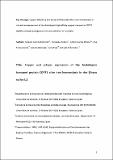Por favor, use este identificador para citar o enlazar a este item:
http://hdl.handle.net/10261/158255COMPARTIR / EXPORTAR:
 SHARE SHARE
 CORE
BASE CORE
BASE
|
|
| Visualizar otros formatos: MARC | Dublin Core | RDF | ORE | MODS | METS | DIDL | DATACITE | |

| Título: | Copper and ectopic expression of the Arabidopsis transport protein COPT1 alter iron homeostasis in rice (Oryza sativa L.) |
Autor: | Andrés Bordería, Amparo; Andrés, Fernando; Garcia Molina, Antoni; Perea García, Ana CSIC ORCID; Domingo, Concha; Puig, Sergi CSIC ORCID; Peñarrubia, Lola | Palabras clave: | Copper Iron Metal transport Oryza sativa COPT1 OsIRO2 |
Fecha de publicación: | 19-jun-2017 | Editor: | Springer Nature | Citación: | Plant Molecular Biology 95 (1-2): 17-32 (2017) | Resumen: | Higher plants have developed sophisticated mechanisms to efficiently acquire and use micronutrients such as copper and iron. However, the molecular mechanisms underlying the interaction between both metals remain poorly understood. In the present work, we study the effects produced on iron homeostasis by a wide range of copper concentrations in the growth media and by altered copper transport in Oryza sativa plants. Gene expression profiles in rice seedlings grown under copper excess show an altered expression of genes involved in iron homeostasis compared to standard control conditions. Thus, ferritin OsFER2 and ferredoxin OsFd1 mRNAs are down-regulated whereas the transcriptional iron regulator OsIRO2 and the nicotianamine synthase OsNAS2 mRNAs rise under copper excess. As expected, the expression of OsCOPT1, which encodes a high-affinity copper transport protein, as well as other copper-deficiency markers are down-regulated by copper. Furthermore, we show that Arabidopsis COPT1 overexpression (C1OE) in rice causes root shortening in high copper conditions and under iron deficiency. C1OE rice plants modify the expression of the putative iron-sensing factors OsHRZ1 and OsHRZ2 and enhance the expression of OsIRO2 under copper excess, which suggests a role of copper transport in iron signaling. Importantly, the C1OE rice plants grown on soil contain higher endogenous iron concentration than wild-type plants in both brown and white grains. Collectively, these results highlight the effects of rice copper status on iron homeostasis, which should be considered to obtain crops with optimized nutrient concentrations in edible parts. | Versión del editor: | https://doi.org/10.1007/s11103-017-0622-8 | URI: | http://hdl.handle.net/10261/158255 | DOI: | 10.1007/s11103-017-0622-8 | ISSN: | 0167-4412 | E-ISSN: | 1573-5028 |
| Aparece en las colecciones: | (IATA) Artículos |
Ficheros en este ítem:
| Fichero | Descripción | Tamaño | Formato | |
|---|---|---|---|---|
| PMB-Andres-2017.pdf | Artículo principal | 1,59 MB | Adobe PDF |  Visualizar/Abrir |
CORE Recommender
SCOPUSTM
Citations
16
checked on 16-abr-2024
WEB OF SCIENCETM
Citations
15
checked on 24-feb-2024
Page view(s)
276
checked on 19-abr-2024
Download(s)
664
checked on 19-abr-2024
Google ScholarTM
Check
Altmetric
Altmetric
NOTA: Los ítems de Digital.CSIC están protegidos por copyright, con todos los derechos reservados, a menos que se indique lo contrario.
